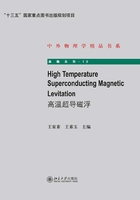
1.10 Type I superconductors
Superconductors can be categorized into two classes, type I and type II. The ratio(1.7.5)of the penetration depthλto the superconducting coherence length ξ is called as the Ginzburg-Landau(GL)parameterκ,which determines whether a material is type I or type II superconductor.For type I superconductors this ratio is

and for type II superconductors,

Most pure elemental superconductors, except niobium and carbon nanotubes, are type I superconductors, while almost all impure and compound superconductors are type II superconductors. Type 1.5 superconductor refers to a multicomponent superconductor which is characterized by two or more coherence lengths, and ξ 1 <
Superconducting materials that completely expel magnetic flux until they be come completely normal are called as type I superconductors. The superconduc tor is in the Meissner-Ochsenfeld state at small magnetic field.The Meissner Ochsenfeld state breaks down when the applied magnetic field has a certain larger value.